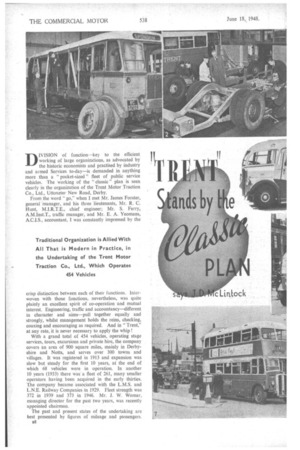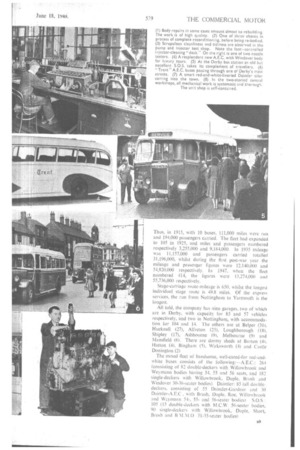D IVISION of function—key to the efficient working of large organizations,
Page 42

Page 43

Page 44

If you've noticed an error in this article please click here to report it so we can fix it.
as advocated by the historic economists and practised by industry and atrned Services to-day—is demanded in anything more than a " pocket-sized " fleet of public service vehicles. The working of the " classic " plan is seen clearly in the organization of the Trent Motor Traction Co., Ltd., Uttoxeter New Road, Derby.
From the word "go," when I met Mr. James Forster, general• manager, and his three lieutenants, Mr. R. C. Hunt, M.I.R.T.E., chief engineer; Mr. S. Ferry, A.M.Inst.T., traffic manager, and Mr. E. A. Yeomans, A.C.I.S., accountant, I was constantly impressed by the crisp distinction between each of their functions. Interwoven with those functions, nevertheless, was quite plainly an excellent spirit of co-operation and mutual interest. Engineering, traffic and accountancy—different in character and aims—pull together equally and strongly, whilst management holds the reins, checking, coaxing and encouraging as required. And in "Trent," at any rate, it is never necessary to apply the whip !
With a grand total of 454 vehicles, operating stage services, tours, excursions and private hire, the company covers an area of 900 square miles, mainly in Derbyshire and Notts, and serves over 300 towns and villages. It was registered in 1913 and expansion was slow but steady for the first 10 years, at the end of which 68 vehicles were in operation. In another 10 years (1933) there was a fleet of 261, many smaller operators having been acquired in the early thirties. The company became associated with the L.M.S. and L.N.E. Railway Companies in 1929. Fleet strength was 372 in 1939 and 373 in 1946. Mr. J. W. Womar, managing director for the past two years, was recently appointed chairman.
The past and present states of the undertaking are best presented by figures of mileage and passengers. B8
Thus, in 1915, with 10 buses, 111,000 miles were run and 194,000 passengers carried. The fleet had expanded to 105 in 1925, and miles and passengers numbered respectively 3,255,000 and 9,184,000. In 1935 mileage was 11,157,000 and passengers carried totalled 31,196,000, whilst during the first post-war year the mileage and passenger figures were 12.140,000 and 54,820,000 respectively. In 1947, when the fleet numbered 414, the figures were 13,274,000 and 55.736,000 respectively.
Stage-carriage route-mileage is 650, whilst the longest individual stage route is 49.8 mile. Of the express services, the run from Nottingham to Yarmouth is the longest.
All told, the company has nine garages, two of which are in Derby, with capacity for 85 and 57 vehicles respectively, and two in Nottingham, with accommodation for 104 and 14. The others are at Belper (31), Hucknall (27), Affreton (25). Loughborough (18). Shipley (17), Ashboiirne (9), Melbourne (9) and Mansfield (6). There are dormy sheds at Burton (4), Hatton (4), Bingham (5), Wirksworth (4) and Castle Donington (2)
The mixed fleet of handsome, well-cared-for red-andwhite buses consists of the following:—A.E.C.: 264 (consisting of 82 double-deckers with Willowbrookand Weymann bodies having .54, 55 and 56 seats, and 182 single-deckers with Willowbrook, Duple, Brush and Windover 30-36-seater bodies), Daimler: 85 tall doubledeckers, consisting of 55 Dainder-Gardner and 30 Daimler-A.E.C. with Brush, Duple, Roe, Willowbrook and Weymann 54-, 55and 56-seater bodies) S.O.S.: 105 (15 double-deckers with M.C.W. 56-seater bodies, 90 single-deckers with Willowbrook, Duple, Short, Brush and B N1.M,O 31-35-seater bodies)
Vehicle "vintages" date from 1932 onwards, most of the A.E.C. and Daimler buses being modern, and many S.O.S. elderly but elegant. Only 36 vehicles are petrol-engined. Thirty-three double-deckers have low-height bodies and 31 have front entrances. Of the single-deckers, 30 are coaches, with Duple, Willowbrook and Windover bodies, the Windover coachwork being mounted on A.E.C. Regal oilengined chassis. New bodies were fitted to older vehicles as follows: 40 in 1948, 10 in 1946, 12 in 1945 and 15 in 1942.
spent an hour or so with Mr. Hunt at the fine central workshops in Uttoxeter New Road, opposite the general offices and the garage. The middle part housed the original workshops, as they were when the British Electric Traction Co., Ltd., took over, but the building has been extended in both directions by stages from those early days. The unusual thing about these workshops is that the unit shop and machine shop are on an upper floor—an arrangement which, I was told, works remarkably well.
Mr. Hunt and I started our tour at ground level; that is, in the dock bay. Roughly, this can be divided into the three sections, body repair, chassis overhaul and specialist shops. One end comfortably houses four vehicles at a time for body repair. At the other end are, say, three chassis in the process of stripping, and several complete vehicles being serviced or repaired. in the middle is room for further servicing and "odd" jobs, Around the circumference are the shops.
Taking the shops first, we glanced at the trimmers busily at work on upholstery and allied fittings, the% went into the fuel-pump and injector test-room. The floor and all the benches were clean; there was a place for everything and everything was in its place. In this shop there is generous equipment on traditional lines, plus a little something. The Crypton Hartridge test machine also tests vacuum-braking cylinders by means of a home-designed" addition. Special equipment, too, has been installed for injector reclaiming. Of the two injector testers, one is of funnel type and the other has a glass case.
Systematic Pump Reconditioning
The injector-cleaning bench is an impressive piece of equipment. Foot control of buffs, brushes, etc., is a noteworthy point; the opetator's hands are left free to handle the delicate mechanisms. For pump overhaul, universal holding jigs are installed on the linoleum-covered benches. Diagrams and working drawings are handy, and inspection lighting is first class. A system of dispatch boxes is employed for receiving pumps, injectors and filters, and for sending them out in a condition as good as new.
In the electrical shop, almost everything except rewinds is done. There is servicing equipment for the B.T.-H., Smith and Record electric speedometers which are used on the buses, as well as a special test rig. My attention was drawn to a simple and effective machine for undercutting commutator segments.
The electrical wiring shop is separate—a sound &nand has a staff of three, as against 12 in the other shop. There are eight charging boards, taking up to 48 batteries.
At the rear of the building we saw the tinsmith's and blacksmith's shops, both among the best of their kind. The spray-paint shop is well lit and, of course, dust-free.
For chassis repairs, light and heavy, there are seven pits. I have seen many ways of disposing of exhaust fumes when running engines, but the Trent way is undoubtedly among the best. Each pit has a big-bore flexible pipe which is thrust on to the vehicle's tail pipe. Gases go through this pipe and into a duct leading to a large vertical extractor chimney in the south wall. The extractor is electrically driven. One pit is reserved exclusively for testers.
In the south-west corner of this floor is the cleaning bay, where all units, after removal from chassis, are made "surgically clean." Rough cleaning is done with a Weaver Steam Jenny and final work with an 1.C.I. hot degreaser. In this bay also are the stairs and hoist shaft to the upper floor and a Stream-Line oil filter. Reclaimed oil is used in bulk with complete satisfaction.
In the north-west corner is the works superintendent's office, well raised to give a view of the whole area.
Before going upstairs we chatted about a few points. "What is your repaint programme?" I asked. "At the present time we are doing three a week," said Mr. Hunt, "but we are planning to increase the number All vehicles s 10 are being changed from red to red and white, some with a dark-red waistband." There are 14 painters and 14 on body repairs. I learned that skilled and semi-skilled maintenance staff totals 237, whilst there are 163 cleaners, greasers, etc., 24 cleaners being women. We went upstairs. I saw a clean, light, airy unit-shop, in which engines in various stages of rebuilding were down the south side and smaller units--gearboxes, differentials, steering boxes and other components—were along the other side. I was impressed with the way in which suitable stands were used for the support of all heavy units in working positions. The benches are left free and tidy for their proper purposes. Part of the upper floor also houses the machine shop, in which every machine has its own motor. There are three lathes, the smallest 5i ins, and the largest a 14-in. by Robsons, of Shipley, I noticed a new Paddon cylinder borer, a cylinder hone—which, I was told, was a converted drilling machine—a shaping machine, a miller converted for special grinding, two pedestal drills and a power hacksaw. There is a Landis crank grinder downstairs.
A Bradbury brake-drum grinder brought us to the topic of brakes. Mr. Hunt said that few modern drums were stout enough for the fitting of liners after turning. He now has thicker drums made by an engineering concens, and this, he declared, improves the standard product.
Colour Identification for Components
Brake drums brought us to another interesting thing. The special drums are coloured with a broad blue band for identification. Every differential casing is coloured brightly, according to worm and wheel ratio. Every standard cylinder block is painted grey ancl every oversize unit green. Any experimental component is also coloured. Storekeeping is an important part of any organization of this kind. At Uttoseter Road, Mr. A. E. Greatorex, chief stores officer since 1921 and a R.E.M.E. major in the 1939-45 war, controls a staff of 14. A separate reference number is allotted to each of the 7,000 items. This number is used for stock record cards, bin cards and location panels of the single-line visible-index pattern. Issues are made on production of requisition slips signed by a works official. Job cards are used for special work, but the cost is not priced out to individual vehicles unless the information is likely to be required for accident claims or other special purposes. For stores accounting, a visibleindex system is used, with appropriate coloured signals to show the stock position. Requisition slips covering stores issues are sorted into part numbers and bulk-issue entries are made on the main stock-cards at two-weekly intervals. Pricing out is done at this stage and stores-issue summary' sheets completed.
Progressive stocktaking is carried out, and this has the effect of covering the majority of stores stocks three times a year, in addition to annual stocktaking. The main stores is at ground level and has a loading bay for lorries. At one end is the special tool store, from which tools are issued apino a brass tally. Separate from the main stores are the spa re-unit stores, holding




















































































